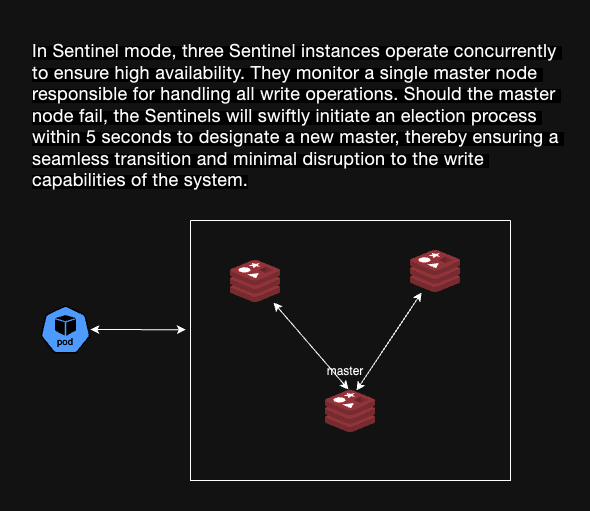Redis Sentinel Mode Overview
Redis Sentinel Mode Overview:
Redis Sentinel is a high-availability solution for Redis. It operates by deploying a distributed system of Sentinel instances that monitor the health and performance of your Redis infrastructure.
Deployment: In Sentinel mode, you typically deploy at least three Sentinel instances to ensure fault tolerance. These instances work in concert to monitor the status of the Redis servers.
Role of Master: There is one primary Redis server designated as the “master.” This is the server that handles all write operations, ensuring data consistency and integrity.
Monitoring: Sentinel instances continuously monitor the master and any replica servers (slaves) for any signs of failure. They check the health of the servers by sending heartbeat messages.
Failover Process: If the master server fails or becomes unresponsive within a specified timeframe (commonly set to 5 seconds), the Sentinel instances will initiate a failover process.
Election of New Master: The Sentinel instances will elect a new master from the available replicas. The election process is based on predefined rules and the health status of the replicas.
Automatic Switchover: Once a new master is elected, the Sentinel instances will reconfigure the replica servers to recognize the new master. They will also redirect any client applications to the new master for write operations.
Resilience and Redundancy: By having multiple Sentinel instances, the system ensures that there is no single point of failure. If one Sentinel instance goes down, the others can still perform the monitoring and failover tasks.
Client Reconfiguration: Applications that are connected to the Redis master need to be aware of the Sentinel system to handle automatic reconfiguration and switchover to the new master without downtime.
Use Case: Sentinel mode is ideal for applications that require high availability and cannot afford to lose write capabilities for an extended period. It ensures that the system can quickly recover from a failure without manual intervention.
By implementing Redis in Sentinel mode, you can achieve a robust, fault-tolerant system that minimizes downtime and ensures continuous availability of your data.
